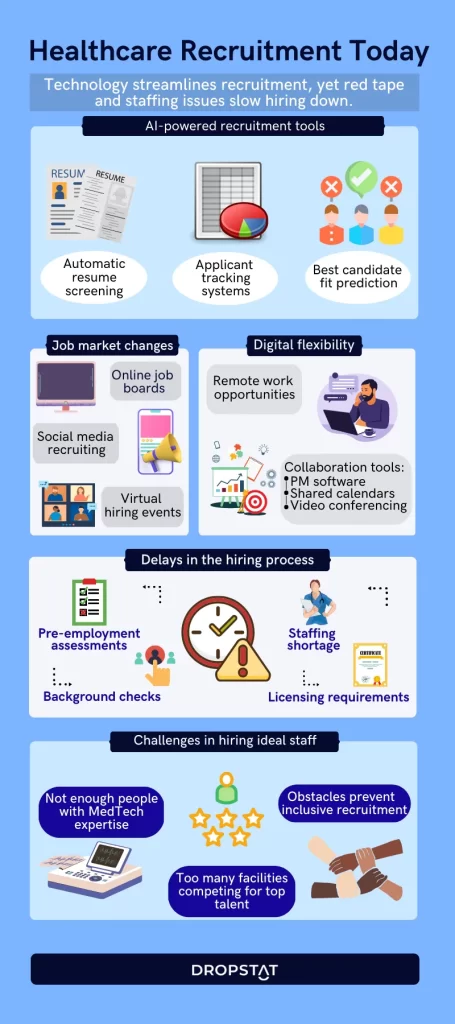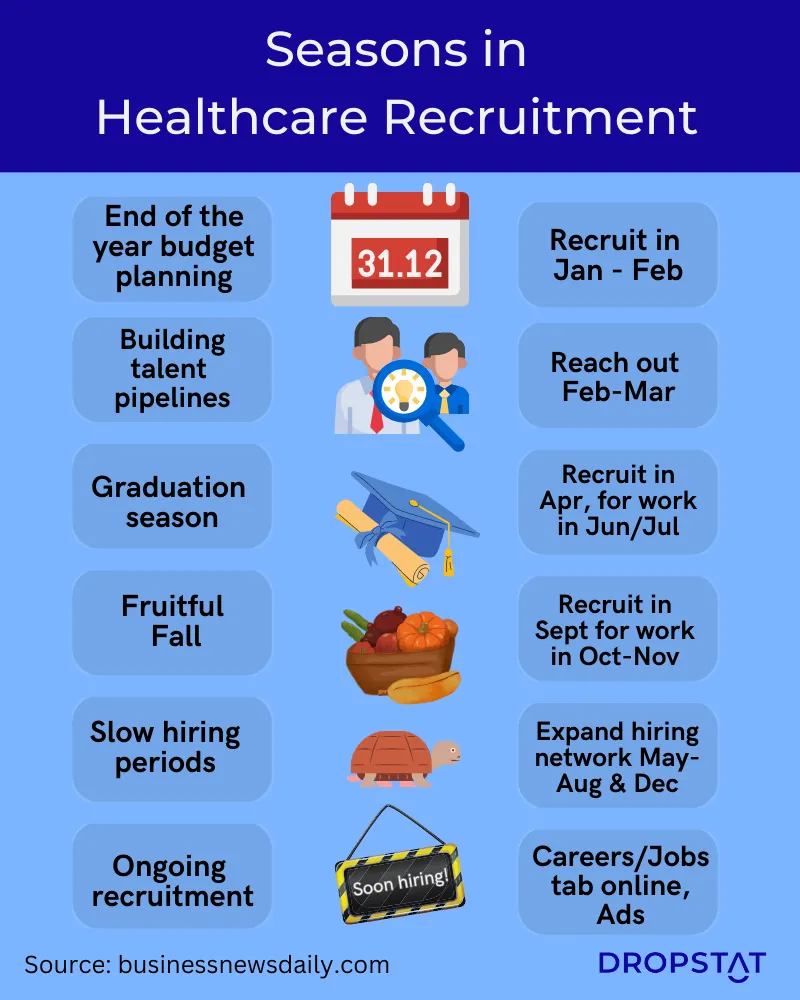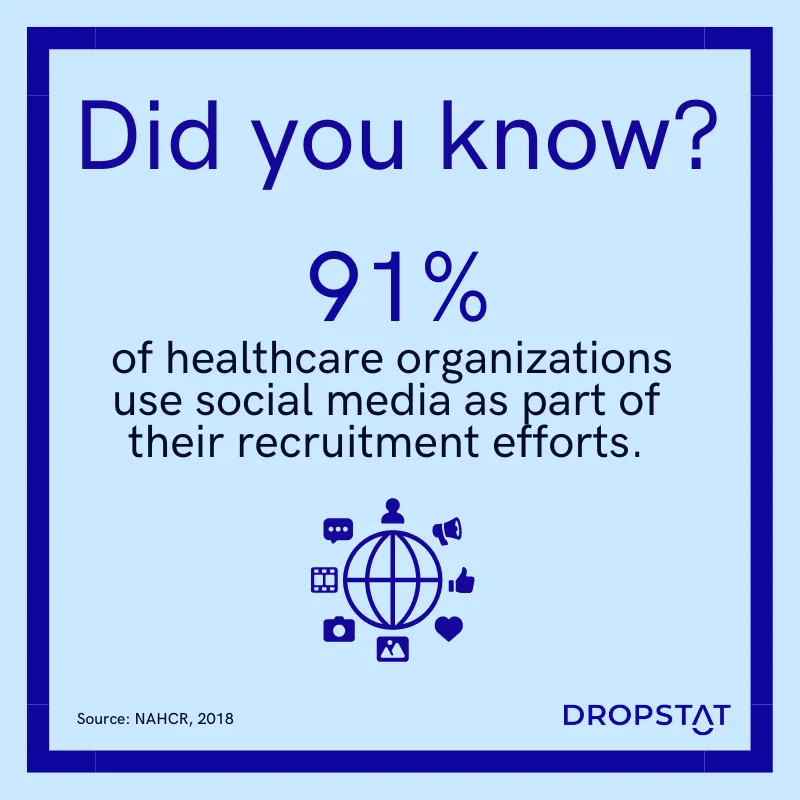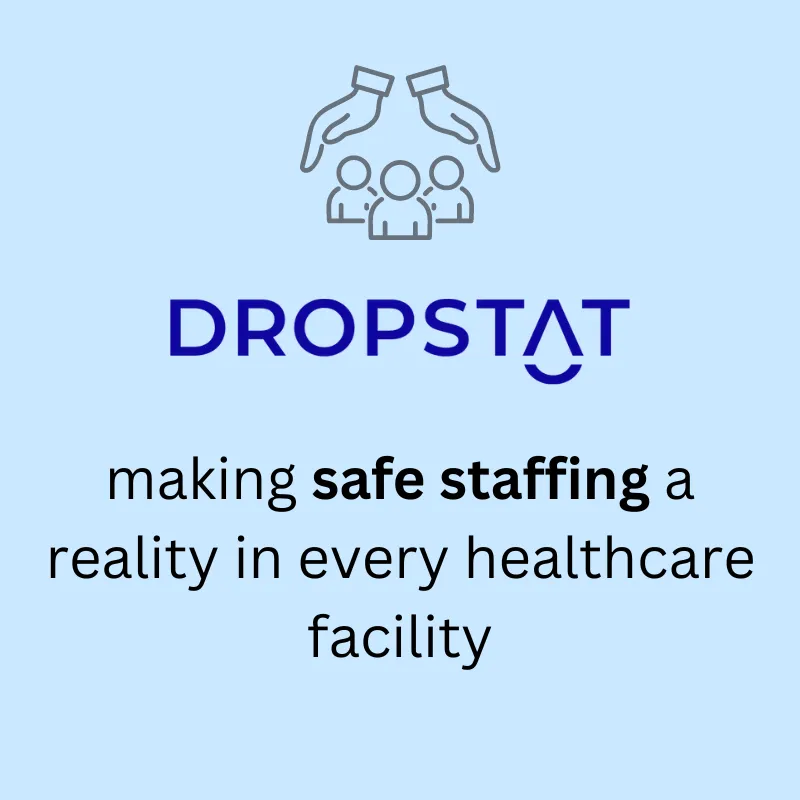When is the peak season for recruitment in healthcare?
Hiring in healthcare depends on different factors, such as the healthcare niche and the location of the facility giving care. The peak season for recruiting in healthcare varies for several reasons.
- From a financial viewpoint, healthcare organizations may see increased hiring activity during the first quarter of the year. That is when healthcare managers usually review and renew hiring budgets and launch new initiatives.
- From a practical viewpoint, there may be increased hiring activity in the summer months. At that time of year, existing staff tend to take vacations, relocate or change jobs, creating more job openings. Many new nurses graduate in the spring and are available for hire in June and July.
- Certain specialties or locations may experience peak hiring at different times. For example, rural areas may have a higher demand for healthcare professionals during the winter months due to seasonal illnesses.
Ultimately, the peak hiring season in healthcare can vary, and it’s important for recruiters to stay aware of industry trends and adjust their strategies accordingly.

Is the hiring of new nurses affected by patient volume trends?
Hospitals may need to hire additional nurses to ensure they can provide high-quality care to their patients at peak times.
During the winter months, hospitals often experience an increase in patient volume due to seasonal illnesses, leading to a higher demand for nursing staff.
During the summer months, hospitals may see an influx of patients due to accidents or injuries associated with outdoor activities.
During the holiday season, hospitals may have to admit more patients due to the outcomes of people drinking and driving, acting impulsively, or overeating.
Healthcare recruiters can use data analytics to take into account historical levels of patient volume when determining their hiring needs. However, hiring cannot tally precisely with patient volume since:
- The traditional recruitment and hiring process takes time, with healthcare employees having an average time-to-hire rate of 49 days.
- Hiring managers are not aware of the current skills that are lacking.
- It is challenging to find enough staff for each department exactly when needed.
Hospitals often use other solutions when patient numbers rise, such as calling in float staff or agency nurses.

How is healthcare recruitment affected by the seasons and time of year?
Healthcare recruitment can be affected by the seasons and time of year in several ways.
- Winter: The winter months are challenging for healthcare recruitment. Many people take time off work and cease job-seeking during the holiday season due to winter illnesses. On the flip side, winter is flu season, which can lead to increased patient volume in healthcare facilities and a higher demand for healthcare workers, creating a seasonal short-staffing crisis.
- Spring: Spring can be a good time for healthcare recruitment. Spring brings renewal and growth for many job-seekers. Many new graduates enter the job market in the late spring and early summer. The number of nursing graduates is estimated to be 155,000 a year. Healthcare organizations may have more budget flexibility to hire new staff. Together, these conditions make it a good time for recruiting new hires.
- Summer: Summer can be a challenging time for healthcare recruitment as many people take vacations and take time off work. However, it can also be a good time to recruit new graduates who are looking to start their careers.
- Fall: Fall can be a good time for advancing existing staff in their careers as part of active staff planning and healthcare recruitment. It is a time of transition and maturing. Many healthcare organizations start planning for the following year’s budget and identifying staffing needs in the fall.
Identifying a healthcare organization’s specific needs and the availability of qualified candidates must go hand in hand with healthcare recruiters being aware of industry trends. This will ensure that recruiters hire the best talent at the right time.

5 healthcare recruitment strategies for effective recruiting outside of the peak hiring season
Here are 5 recruitment strategies in healthcare that are effective outside of the peak hiring season:
- Build a talent pipeline: During slower hiring periods, healthcare recruiters can focus on building a pipeline of qualified candidates for future hiring positions. This involves identifying potential candidates through various channels such as social media, job boards, and referrals. Recruiters can establish relationships and keep them informed about future job openings.
- Leverage referrals: Employee referrals can be a powerful tool for healthcare recruitment, especially during slower hiring periods. Recruiters can actively encourage current employees to refer their friends and colleagues, offering incentives such as bonuses or other rewards for successful hires.
- Utilize social media: Healthcare recruiters can focus on social media campaigns using platforms such as LinkedIn, Facebook, and Twitter to engage with potential candidates, promote their organization’s culture and values, and share job openings.
- Have a presence at job fairs and conferences: Job fairs and industry conferences can provide healthcare recruiters with opportunities to connect with potential candidates outside of the peak hiring season. Recruiters can showcase their organization’s culture and job opportunities, network with industry professionals, and establish relationships with potential candidates for future positions.
- Offer flexibility: During slower hiring periods, healthcare recruiters can attract top talent by offering flexibility in terms of work hours or schedules. This can include options such as remote work or flexible hours, which can be especially appealing to candidates who are seeking a good nurse work-life balance.
These strategies can help recruiters connect with and attract qualified candidates even when hiring demand is lower than usual.

Software for effective recruitment in healthcare
There are several software and technologies that can help healthcare recruiters streamline their recruiting processes and improve their hiring outcomes. Here are a few examples:
- Applicant tracking systems (ATS): An ATS is a software system that allows recruiters to manage recruitment at every stage. ATS can help recruiters automate and streamline their recruiting tasks, saving time and resources and improving the quality of hires.
- Talent relationship management (TRM): TRM software helps recruiters build relationships with potential candidates over time, even if there are no immediate job openings. TRM software can help recruiters engage with candidates through targeted marketing campaigns, content sharing, and social media outreach.
- Video interviewing: Video interviewing enables recruiters to conduct virtual interviews with candidates, which can be especially useful during times when in-person interviews are not possible or convenient. Video interviewing software can help recruiters and applicants save travel time and costs and increase availability. This enables recruiters to quickly assess more candidates for communication, skills, and job fit.
- Candidate sourcing tools: These tools help recruiters identify and attract top candidates by leveraging online job boards, social media platforms, and other resources. Candidate sourcing tools can help recruiters save time by automating the search process and providing access to a larger pool of potential candidates.
- Analytics and reporting: Analytics and reporting software for recruitment can help healthcare recruiters track key performance metrics such as time-to-hire, cost-per-hire, and quality of hire. This data can help recruiters identify how efficient the healthcare facility’s recruitment and hiring process is. Recruiters can identify areas for improvement, measure the effectiveness of their recruiting strategies, and make data-driven decisions about their hiring processes.
Overall, recruitment technology can help healthcare recruiters improve their efficiency, effectiveness, and quality of hires by automating and streamlining their recruiting processes, building candidate relationships, and leveraging data and analytics to make informed decisions.
How Dropstat uses data analytics to help healthcare recruitment become faster and more effective?
Dropstat is an AI-powered staff scheduling app that uses data analytics to identify skills gaps and staffing needs. Dropstat can help healthcare recruiters effectively target nurses and other healthcare professionals.
Dropstat analyzes all shifts and nursing disciplines so that they meet the legal ratios up to two months in advance. Staff schedulers can see at a glance in a clear, accessible format – if a shift is not fully staffed. And recruiters are kept up to date on skills gaps that are missing within the existing staff pool. Recruiters and schedulers can meet to confirm the need for new staff in advance. This gives recruiters a heads-up so they can recruit exactly the right hires with the desired skill sets.
Dropstat analyzes historical staffing data to identify patterns and trends in staffing needs, together with analysis of employee attendance data. Schedulers are aware of which shifts or times of the year typically experience staffing shortages and can prepare accordingly. Healthcare data analytics can be used to inform future staffing recruiting decisions and to help ensure that safe staffing levels are maintained.
Schedule a demo to see how Dropstat can help your healthcare organization to optimize its staffing processes, identify skills gaps, and proactively address and speed up the recruitment process.







